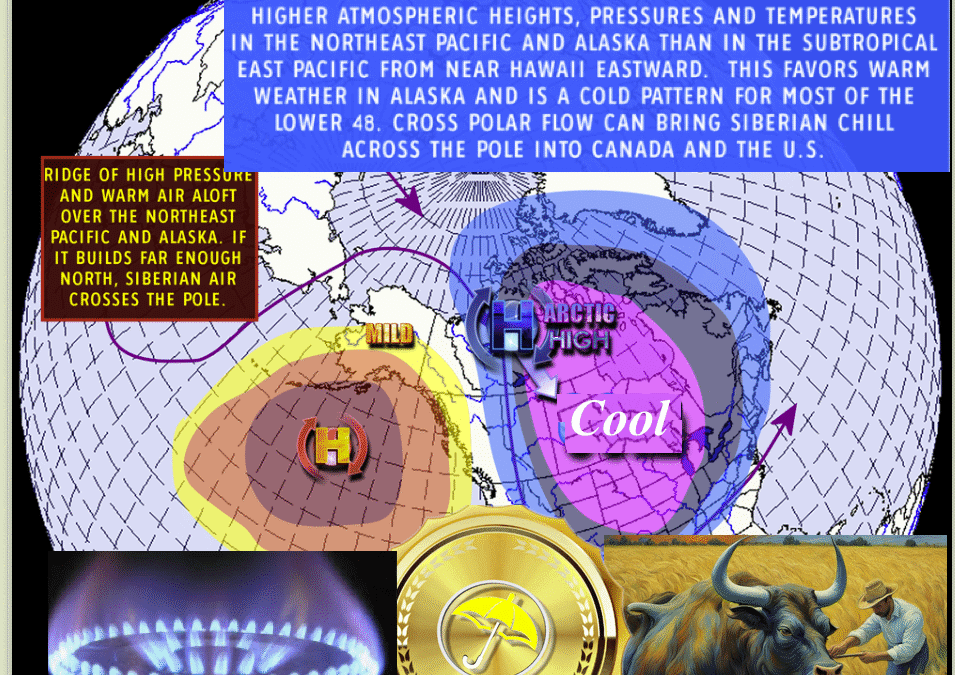In This Report:
Introduction: The EPO index (map on top of the page) is acting as a bearish influence on natural gas, corn and soybean trading
My original May forecast for July looks like it will be more accurate
How I got a bit fooled this time by the GFS model
Introduction
The map at the top of the report, depicting a negative Eastern Pacific Oscillation Index, is most important during the winter months for natural gas trading. The warm block near Alaska above 15,000 feet can send the Polar Vortex south, thus exciting energy traders. However, in the case of summer weather, its influence can vary depending on whether or not there is a La Niña and hot southern U.S. ridge to deflect its cooling influence.
My cocoa video is delayed until Sunday night EDT
My original May forecast for July looks like it will be more accurate
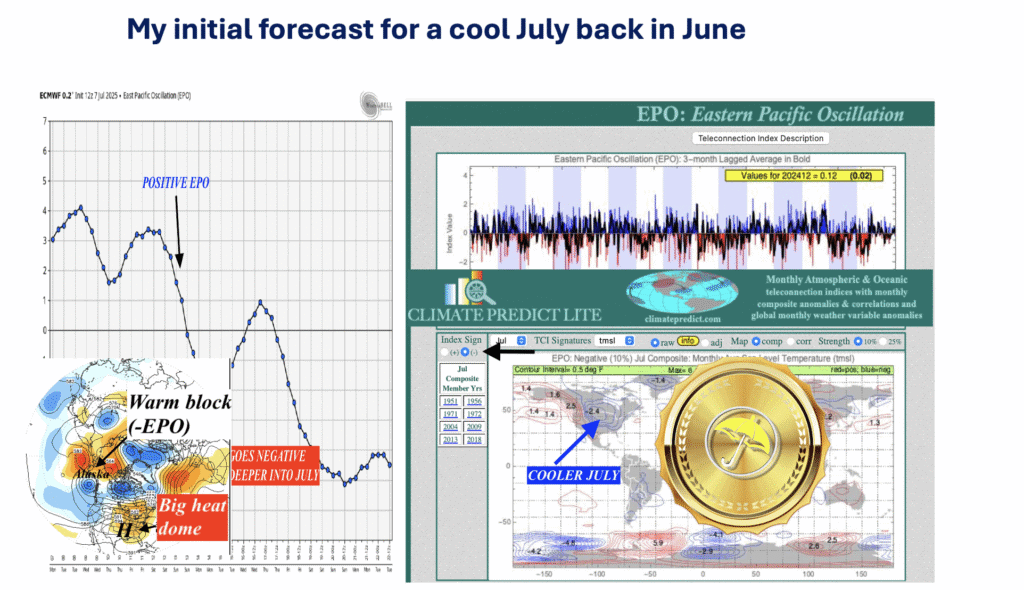
Not an exact fit. While I do not expect the Midwest to be this cool, the effects of the negative EPO, without a strong La Niña based dome should prevent any major consistent Midwest heat and will bring big cooling to the eastern US natural gas demand areas.
How I got a bit fooled this time by the GFS model
If you are a corn trader: no harm done. I had advised traders to exit short positions, a week or so ago, right near the lows. I had been bearish for the last three months.
For soybeans, the market has rallied a bit on Trade Tariff hopes and some short-term extreme heat in the Southwest soybean belt, but it will not last. So… here too, no harm done.
Weather models can drive a meteorologist nuts trying to compare different ones and to “second guess” them. I usually pride myself in being able to disagree with most of them.
In the last three summers, I have disagreed with many forecasters out there about a summer bull market in grains and consistent La Niña based summer heat and dryness. However, because we have an “El Niño neutral” event (in between El Niño and La Niña) this can make long-range weather forecasting a bit more tricky,
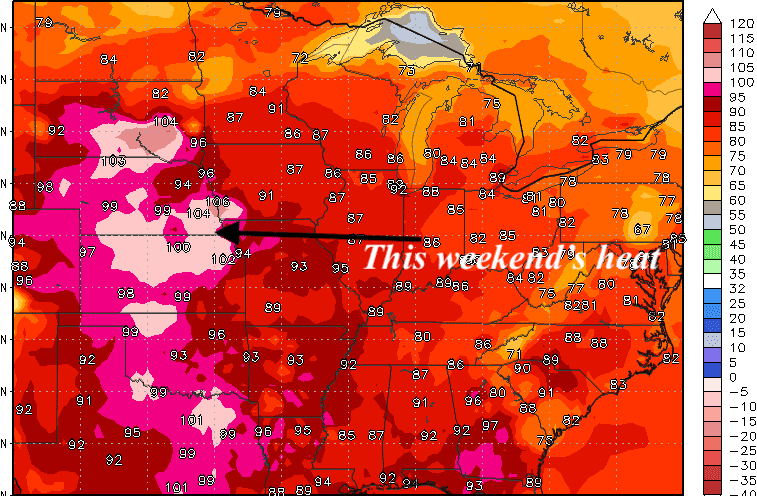
Why I got concerned last week not to be short corn and soybeans anymore.
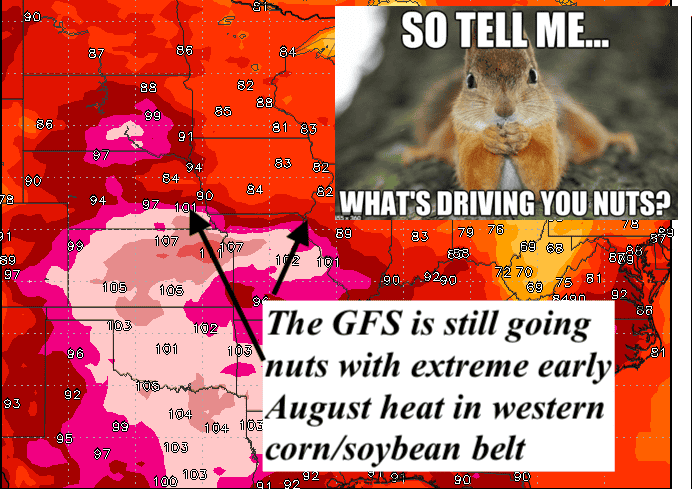
If the GFS is correct, a potential bull market in soybeans and corn prices staying above $4.00 would be likely. Right now, I do not believe this.
However, it is usually during La Niña events or rapidly weakening El Niño events (such as in 1983) that the extreme major heat and dryness dome persists in summer. This was discussed in my grain video last week.
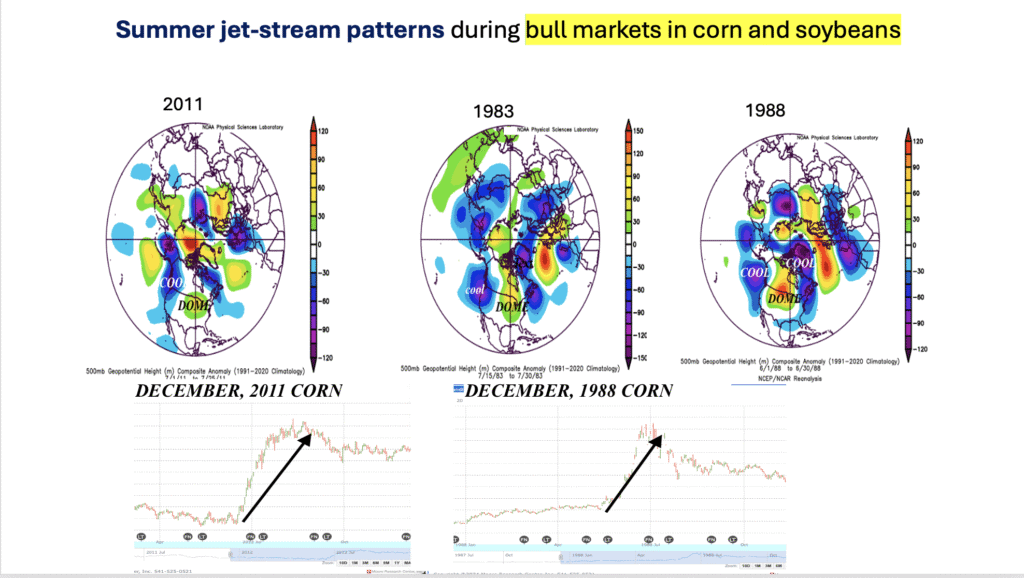
Since La Niña is not forming yet, I tend to believe this model (not the GFS) due to the negative EPO. This helped break corn futures again, in the last two days, and create a massive spiral down in natural gas prices.

Bottom line corn and soybeans:
There are very few dry areas in the Midwest corn and soybean belt. While I mentioned a few days ago that warm night-time low temperatures over 50% of the corn belt could lower corn yields a bit, this is not really in the cards for more than just a few days. Hence, a potential record corn crop could indeed pressure prices below $4.00 after the August USDA crop report and/or during harvest. For soybeans, while I was cautiously bullish in last week’s BestWeather Spider, I am going to advise liquidating any long positions in the ETF (SOYB). Some of you emailed me you bought soybean futures. I do not have a lot of confidence prices will go higher, so I am advising getting out of any long positions.
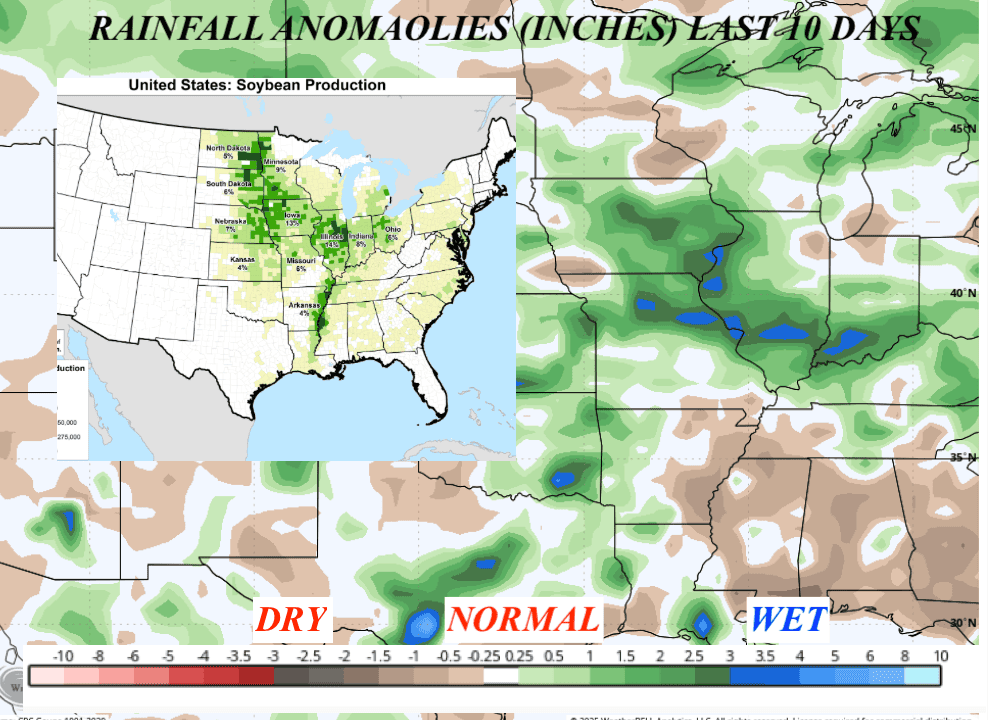


Natural Gas prices could head to $3 without sustained European and US heat
It was in the natural gas market that I have been wrong; which is unusual for me if you were following my advice the last two or three summers and winters.
Nevertheless, some 15-20¢ higher than this in natural gas early on Monday. morning, I mentioned this cooler weather coming towards the Northeast and that this was “not bullish” and my Weather Spider should be more neutral. When I see something with less confidence, usually the thing to do is “get out” of a position or do nothing if you are not in.
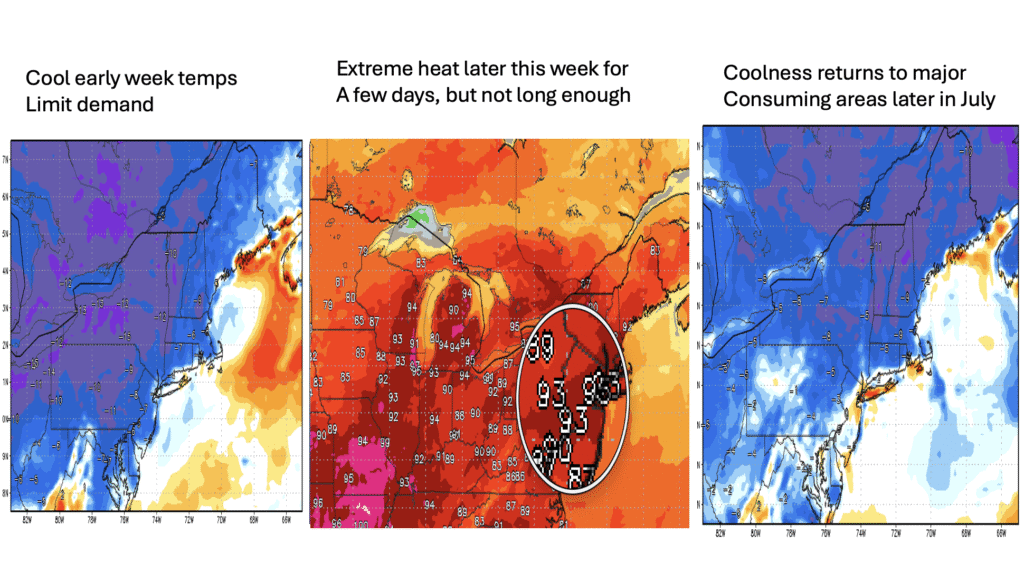
Three maps from Monday’s video. (This is why natural gas prices collapsed)
WEATHERWEALTH TRADE IDEAS
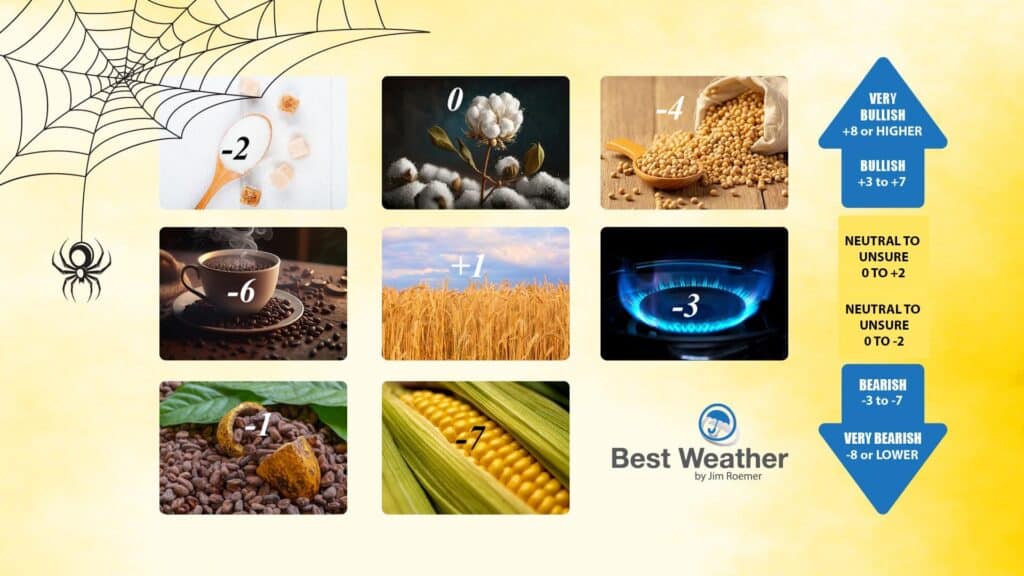
Weather Spider Summary:
The BestWeather Spider has been all over the place for natural gas the last few weeks, so, please accept my apologies. It’s a shame, because two weeks ago my Spider was a very bearish (-8); but I got caught up in the short-term big US heat and strong LNG exports to Europe. Now, with cooler weather, there is very little chance for any more than a 10-20¢ rally the next week or two, at the most.
With a record US corn crop, the Spider was lowered from neutral last week to quite bearish again.
My slightly bullish soybean Spider (20¢ below this) is now changed to bearish.
Potentially, the cocoa Spider is bearish longer term, later, but in the short term, due to a seasonal bullish tendency and tight supplies coming out of West Africa, is more neutral.
In sugar, the Spider is neutral to slightly bearish. A rebound in global sugar production and an excellent Indian Monsoon is bearish vs ideas that Brazil will convert more sugar cane to ethanol and biofuels. Otherwise, the Spider would be very bearish.
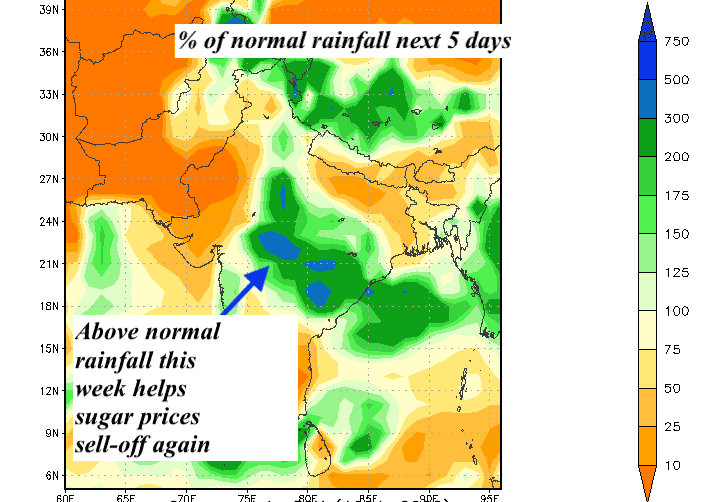
My coffee Spider is bearish longer term and has “consistently” been one of my best and highest confidence trades since the $3.50 area several months ago. It is possible that an over-sold situation on worries over Trump Trade Tariffs could result in a rally, but global weather, especially Robusta, has been bearish for weeks.
Wheat has a strong seasonal tendency to favor the long side vs improving global spring wheat crops and poor technical picture.
Cotton, I am not following; too busy
Trade Ideas:
Exit any long soybean positions such as the ETF (SOYB). My bias is bearish again. If November soybeans can rally above $10.40 on the short term western Midwest heat and Trade Tariff hopes, one can take a chance to sell futures and risk 15-20¢.
Corn will likely go below $4, so… “read between the lines” if you want to trade it again. I already had one nice winning trade since April, being short the market, but getting out near the lows, last week. Otherwise, do nothing right now – but, I see very little chance for a bull market in corn.
Long the March, 2026 $3.00-$2.50 coffee put option spread from more than a month ago and ahead over $2.000/contract. Potential profits could be over $4,000 if we have decent October-December weather for Brazil and prices fall below $2.40. I am not recommending short call options currently as I already had a “home run” a month ago selling $4.00-$4.50 calls for over $5,000/contract profit. Eventually, coffee prices should fall to $2.00-$2.30 if my long-range weather forecast is correct, later this year (no change in my comments 2-3 months ago).
Selling December cocoa in the $7,500-$7,600 area with an $8,000 stop. However, due to seasonal bullish tendencies and the fact the market has already broken 15-20%, I am not sure if prices will trend higher first. The weather in West Africa is improving.
My cocoa video will be on Sunday night EDT, as I am backlogged with grain and natural gas.
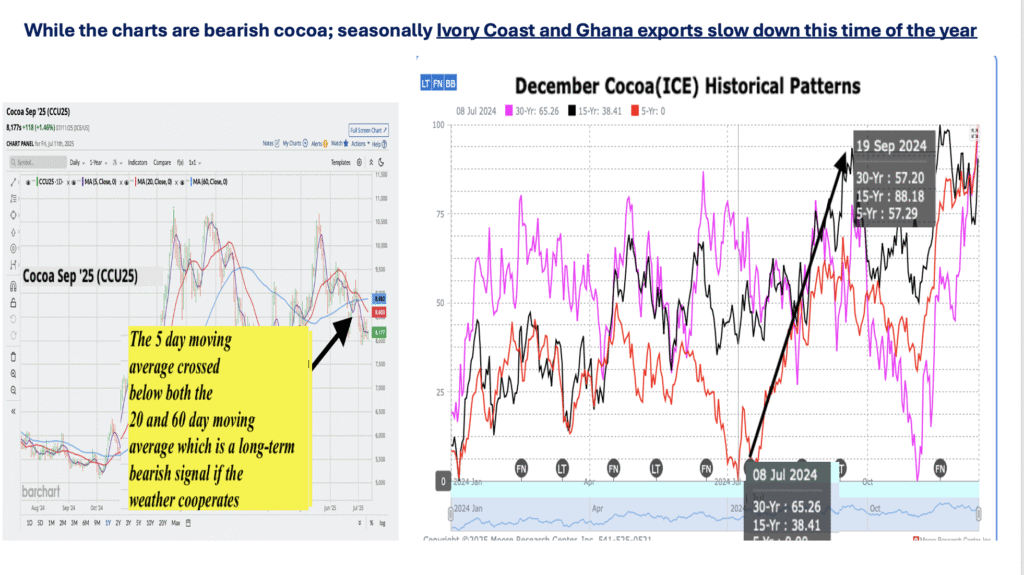
Stopped out if you were long the natural gas ETF (BOIL) on Tuesday with a 10% loss, although my extensive video on Monday backed off on my bullish attitude, so read between the lines. A month ago, my original idea was to sell the September $4.30-$3.30 strangle to capture summer weather market volatility. However, with a cooler overall outlook, I would liquidate that position. At this juncture, that trade is just about even. Now, it’s a little bit too late to sell in the hole.

